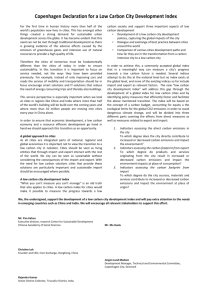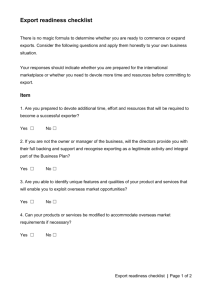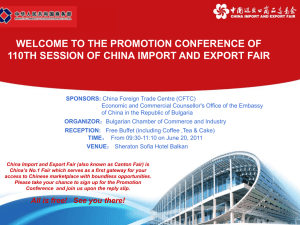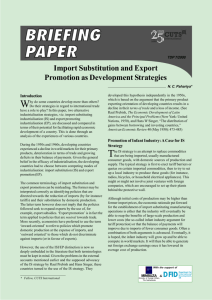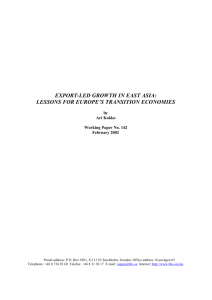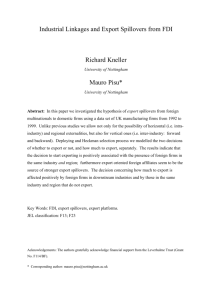Regional Economics- Introduction to Basic Concepts
advertisement
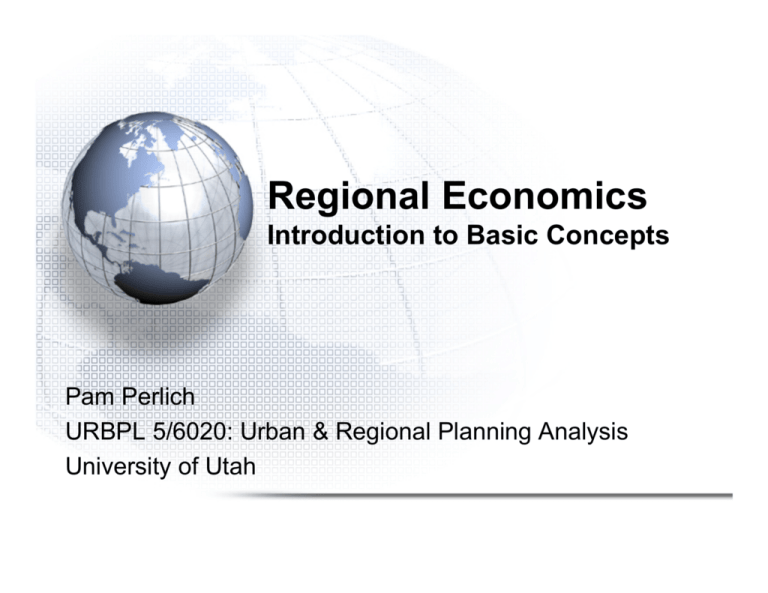
Regional Economics Introduction to Basic Concepts Pam Perlich URBPL 5/6020: Urban & Regional Planning Analysis University of Utah Regional or Spatial Economics • Economic Geography adds the dimension of geography to economic analyses • Focus on location of industries, housing, commerce, public institutions over time • Key concepts: proximity, concentration, dispersion, comparative spatial patterns • Concerned with trade flows, labor flows, and resource flows, among others Relevance to Urban Planners • All planning efforts are financially constrained • Planning practices and zoning have economic costs and consequences – Property values; government revenues; transportation, environmental, and other impacts • Market for land is not a “free” market, but is heavily regulated • Spatial arrangement of cities – Has economic consequences, positive and negative – Travel and other costs • Urban planners can benefit from an understanding of – their regional and local economic contexts – How their proposed policies impact but are also impacted by economic constraints and conditions Levels of Geography • Economic geography – Global production patterns and trade – Unit of analysis: nation state and multinational corporate enterprises • Regional economics – Generally sub-national – May be rural or urban – Activity within a region may be analyzed at a small scale – BEA defines economic regions based on market integration, mostly based on commuting patterns (labor markets) Applied Regional Studies • Economic development: – How and why does it occur in different places? • Industrial location: – Why do particular industries locate in particular places? • City location: – Why are cities located in particular places? Economics / Economic Systems • Production – What is produced • Goods and services – How it is produced • Resource allocation • Technology • Labor • Distribution – Trade and markets – Rules for distribution • Market and non-market – Who gets what and why Concepts Used by Economists to Describe and Explain Market-Based Economies • Market incentives – Income, employment, profits, accumulation • Profit maximization – Revenues and Costs – Short run and long run • Assets and liabilities – Financial – Physical • Efficiency – Producing the most with a given set of resources • Equity – Social / distributive justice • Market Failures – Not all transactions are subject to market pressures – Government actions are required Market Dynamics • • • • • • • Economic fluctuations: season, cycle, trend, structure Markets – emerge, evolve, integrate, disintegrate Technology – production, distribution, products / services Political forces – stability, control, chaos Products – invention, innovation, obsolescence Distribution channels – retail, wholesale Finance – Buyers ÅÆ sellers – Debtors ÅÆ creditors • Competition Îinnovation Îprofits • Labor migration / regulation Regional Export Industries: Trade and Income Effects REGIONAL EXPORT (BASIC) INDUSTRIES •Produce goods and services to sell to the outside world •Employ residents of the region •Purchase inputs from other firms in the region •Generate income for the region Export Goods / Services Injection of Income CUSTOMERS OUTSIDE THE REGION •Import goods and services •Send income to the export regions Purchasing Imports: Trade and Income Effects REGIONAL BUSINESSES AND CONSUMERS •Purchase goods and services from the outside world oHousehold demand oBusiness demand •Send income and spending to the outside world Import Goods / Services Leakage of Income BUSINESSES OUTSIDE THE REGION •Export goods and services •Receive income and spending from the regions to which they export their products Classification of Industries: Export or Basic • Industries located in the region that are generally classified as export base or basic – – – – Agriculture Mining Manufacturing Federal Government • These bring income from outside the region. Classification of Industries: NonBasic or Residentiary • Local Government (municipal services, public education) • Finance (finance, insurance, real estate) • Trade (wholesale and retail) – Exception – tourists • Goods and services provided in the region for the residents of the region. • The larger the the nonbasic sector, the higher the multiplier Classification of Industries: In Some Cases It Depends • Transportation, communication, and public utilities – Depends upon the location of the users • Import substitution – An industry may emerge to serve the population where previously imports have been the source of the products. Trade & Economic Development • Small isolated coal mining community – Exports all of its production of coal – Must import the majority of products used by residents – food, clothing, household good, cars, etc. • Large integrated metropolitan area – Produces some products for export – Produces some products to supply the residents of the region Size and Economic Impacts • Small less developed communities – Economic Base (Export Share) is a greater proportion of the economy – Large spending leakages Î small multipliers • Large integrated metropolitan area – More residentiary production – Smaller spending leakage Î larger multipliers Zero Sum Game • Assume that a market has just enough retail capacity in grocery stores • Another grocery store chain wants to enter the market and seeks government subsidies to do so • Problem – This does not constitute growth in the economy – Simply rearranges existing spending Economic Growth & Development • • • Economic Growth – quantitative change Economic Development – qualitative or structural change Export led growth theory A region increases in wealth and income with 1. Increases in exports 2. Increased import substitution • Economic Development Policy – Costs and Benefits of Economic Development Linked Industries • Forward Linked Industries: Supply Inputs • Backward Linked Industries: Purchase outputs and use these as inputs • Economic Development of Industries Î – Development of these linked industries – A larger skilled labor pool – Scale economies Models Used by Regional Economists • Demographic and Economic Projection Models – Growth of the economy Î population growth • Economic Base Models – Identify basic industries – Develop forecasts of growth • Input-Output Models – Analyze the inter-industry linkages Location of Industries • Complete or partial immobility of land and other productive factors – Comparative advantage Î specialization in production & trade • Economies of concentration (agglomeration) • Costs of transport and communication Technical Names • Imperfect factor mobility • Imperfect divisibility • Imperfect mobility of goods and services Advantage of Cities • • • • • • Central Place Theory Proximity to resources and services Agglomeration economies Concentration of buyers and sellers Increased competition among sellers Large pool of buyers Walter Christaller • German geographer – 1933 work • Economic importance and city size are directly related • Cities maintain “distance intervals” to not cut into each others’ markets Johann Heinrich von Thünen • Economic model of cities – The Isolated State (1826) • Land prices increase towards the center • Transport costs increase further from the center • “Land-price gradient” Graphic from: http://geography.about.com/ William Alonso • Built on von Thünen’s ideas to explain land use patterns. – Location and Land Use (1964) • His model assumes that the city: – – – – Is flat and featureless Has a single CBD Has efficient transportation Economic self interest motivates people • Results: – Only highest value activities are in CDB – Residences and agriculture are in the periphery Alfred Marshall • British economist (1842-1924) who developed microeconomic models – – – – Supply and demand characteristics Market dynamics – short run, long run Method of comparative statics Cost theory • Studied internal dynamics of industries and cities Marshall’s Explanation of Cities • Human capital and knowledge spillovers – Workers find employment & firms labor • Input markets – Backward linked industries reduce costs • Labor market pooling – Pool of skilled labor share knowledge – Great advantage to employers Paul Krugman • Economies of scale in manufacturing • Locate industry to minimize transportation costs – Balance access to inputs and customers – Minimizes costs of production and distribution • Beneficial to consumers - cost Robert Lucas • Human capital – education, training, experience • Spillovers – productivity benefits transferred among workers • Productive exchanges increase with greater access to colleagues • Cities have greater concentration of human capital Æ self reinforcing Contested Theories • Much debate / research concerning the relative importance of these influences of urban growth – Natural advantage, infrastructure, markets, labor, education • Other determinants: – Politics – Amenities / quality of life New Economic Growth Theory • Traditional regional economics has merged with new economic growth theory • Cities are centers of idea creation and transmission • Role as intellectual centers is increasing • Key concepts: – Role of technology – Intellectual spillovers – Human capital spillovers Why Do Cities Exist? • To reduce transportation costs for people, goods, and ideas • Goods – Classic manufacturing cities of 19th century – Advantage declines over time • Transportation costs decline • Manufacturing leaving cities • People: Labor pooling Î innovation – Cities are centers of innovation – Innovation Î economic success Modeling Spatial Patterns • Optimization models – Locate economic activities to maximize profits – Locate households to maximize utility • Bundled costs: housing and transportation – Transportation models • Gravity models – Given a specific origin and a set of possible destinations – Probability of selecting a specific destination is greater when the destination is closer and larger Conclusion • Traditional regional economic models provide a useful framework to understand economic development. • There are limitations to the use of traditional regional economic models. • Theories have been updated to incorporate the insights from new economic growth theory. • There are a set of models commonly used to evaluate regional economies. • Choice of model depends upon the purpose of the analysis, the audience for the work, and the perspective of the analyst.


